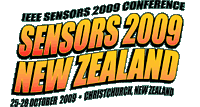

|
Tutorials Micro-Optic and Fiber Optic Sensors Terahertz Sensing Noise Harvesting Chemical and Gas Sensing Industrial Tomography Silicon Piezoresistive Stress Sensors Miniaturised Space Payloads Integrated Gas Sensors Sensors as Communication Channels Nanophotonic Sensors Biopolymer Detection Integrated Radar Sensors Ultrasonics |
The quality and safety of the food we eat attracts a great deal of publicity, and a demand for fresher, better-tasting, safer, healthier and higher quality food is escalating in every country. We live in a global marketplace, and we eat a great variety of foods from many different countries. Many fruits, vegetables and dairy products now on the market were not available ten years ago. These are grown using a variety of production practices, from small organic operations to large-scale mechanized farms. On the one hand, produce buyers want to be reassured that farmers are taking reasonable steps to ensure that the produce delivered is safe and free from human pathogenic bacteria and mycotoxins. On the other hand, consumers and food handlers (restaurateurs, retailers, etc.) need to know that the food which they eat and serve is safe and healthy. In addition to conventional analytical techniques, new instruments and tools are being envisaged that are capable of reducing the costs of quality control and of alerting people of the onset of risks. Also, new instruments for traceability and certification are needed, especially those based on low-cost techniques. The associations of producers and small farmers are increasingly demanding cheap and effective control devices, which are mainly considered as marketing tools for the protection of 'locally-grown' traditional foods. These foods are renowned, and need to be protected from adulteration and imitation, in view of their high qualitative standards, safety, and nutritional excellence. Sensors based on optic and micro-optic techniques are found to offer effective and low-cost solutions for many industrial and process control applications. Especially in the case of spectroscopy-based devices, the intrinsic optical and mechanical characteristics of optical fibers, together with the wide availability of bright LEDs and portable spectrometers, have made it possible to implement compact instrumentation with a high potential for many applications in the food sector. The scope of this tutorial is to present a selection of spectroscopy-based fiber-optic and micro-optic devices that have been designed and tested for monitoring the quality and safety of typical foods, such as extra virgin olive oil, wine, whisky, beer, tequila, honey, milk, and many others. These sensors belong to two different types: those performing direct spectroscopy on the food sample, and those making use of an optical transducer which changes color or fluorescence according to the analyte under test. Other sensors proposed by the tutorial will address the problem of smart and active sensorized-packaging, for non-destructive testing of food quality. Typical examples are sensors embedded in the packaging, such as those capable of measuring the oxygen content in modified atmosphere packed food, or smart caps capable of an olfactory perception of food aroma. All sensors presented in this tutorial have been used in practical applications, providing optical solutions to monitoring problems looking for simple, fast, low-cost and reliable devices. Biography Anna Grazia Mignani is working at CNR-Institute of Applied Physics 'Nello Carrara', Italy. Her backgroung includes a laurea degree in Physics and a PhD in Electrical Engineering-Non Destructive Testings. She has 23 years of experience in optical fiber sensor technology and passive guided-wave components. She has implemented fiber optic sensor prototypes for industrial process control, for medical and environmental applications for the protection of the cultural heritage and, more recently, for the assessment of food safety and quality. She has written over 100 publications and some book chapters, holds 5 US patents, and has chaired international conferences, schools and colleges on optical sensing. |
|||||||
Copyright 2008, All Rights Reserved, IEEE Sensors 2009 and interteq.com